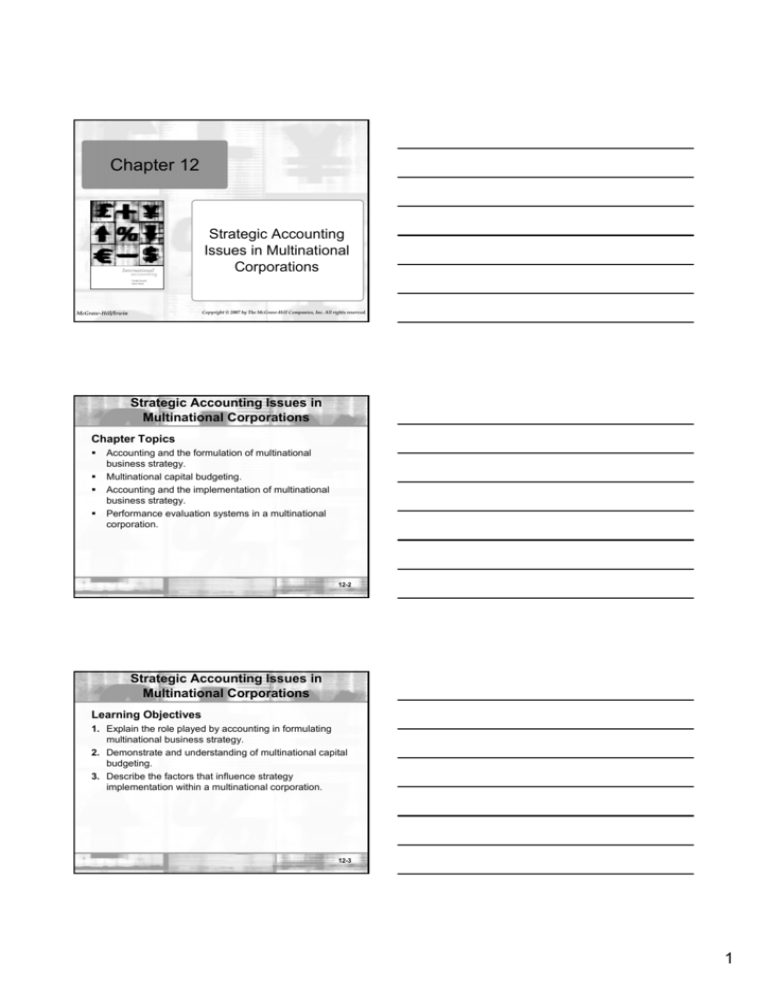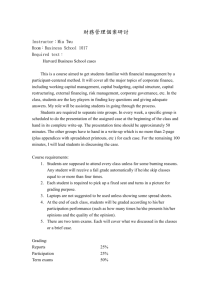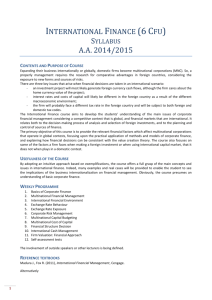
Chapter 12
Strategic Accounting
Issues in Multinational
Corporations
McGraw-Hill/Irwin
Copyright © 2007 by The McGraw-Hill Companies, Inc. All rights reserved.
Strategic Accounting Issues in
Multinational Corporations
Chapter Topics
Accounting and the formulation of multinational
business strategy.
Multinational capital budgeting.
Accounting and the implementation of multinational
business strategy.
Performance evaluation systems in a multinational
corporation.
12-2
Strategic Accounting Issues in
Multinational Corporations
Learning Objectives
1. Explain the role played by accounting in formulating
multinational business strategy.
2. Demonstrate and understanding of multinational capital
budgeting.
3. Describe the factors that influence strategy
implementation within a multinational corporation.
12-3
1
Strategic Accounting Issues in
Multinational Corporations
Learning Objectives
4. Discuss the role of accounting in implementing
multinational business strategy.
5. Identify the issues involved in the design and
implementation of an effective performance evaluation
system within a multinational corporation.
12-4
Strategy
Strategies are large scale plans that reflect the desired
direction of the company.
Strategy formulation involves determining organizational
goals and strategies to achieve those goals.
Strategy implementation involves managerial efforts to
influence employees to attain organizational goals.
Managerial influence is also referred to as management
control.
Accounting has a significant role to play in strategy
formulation and implementation.
12-5
Accounting and Strategy Formulation
Information is a key ingredient in the strategy formulation
process providing information about both internal and
external factors.
This involves analysis of customer, market, and
competitor information, risk assessment.
It also includes financial expressions of firm strategy and
preparation of budgets.
Capital budgeting is an important part of strategy
formulation.
Learning Objective 1
12-6
2
Accounting and Strategy Formulation
Budgeting
Budgeting is the primary use of accounting information in
strategy formulation.
Budgeting assists in strategy formulation by providing
managers with information about short-term and longterm planning responsibilities.
Budgeting also provides expectations against which
future results can be judged.
12-7
Learning Objective 1
Capital Budgeting
Overview
The fundamental concepts of capital budgeting are the
same in either a domestic or international context.
Large, long-term investments are referred to as capital
investments.
Capital budgeting is a key activity in selecting capital
investments.
Capital budgeting involves three steps: project
identification and definition, evaluation and selection,
and monitoring and review.
12-8
Learning Objective 2
Capital Budgeting
Steps in capital budgeting
Project identification and definition provides a clear basis
for understanding the project and predicting the
associated cash flows.
Evaluation and selection involves identifying cash flows
and then using one or more of the capital budgeting
methods to evaluate the project.
Monitoring and review involves updating the analysis
and project plan during the implementation stage.
Learning Objective 2
12-9
3
Capital Budgeting
Capital budgeting techniques
Payback period.
Return on investment.
Net present value.
Internal rate of return.
12-10
Learning Objective 2
Capital Budgeting
Payback period
Represents the length of time it takes to recoup the initial
investment.
Equal to the initial investment amount divided by the
annual after-tax cash flows.
The project will be accepted if the payback period does
not exceed a predetermined length.
The primary weaknesses of this method are that it
ignores the time value of money, and it ignores the total
profitability of the project.
12-11
Learning Objective 2
Capital Budgeting
Return on investment
Represents an average annual return on the initial
investment.
Equal to the average annual net income divided by the
initial investment.
The project will be accepted if the return on investment
exceeds a predetermined rate.
The primary weaknesses of this method are that it
ignores the time value of money, and it ignores possible
cash outlays subsequent to initial investment.
Learning Objective 2
12-12
4
Capital Budgeting
Net present value
Equal to the present value of net future cash flows less
the initial investment.
Requires the estimate of minimum rate of return to be
used as the discount rate.
The project will be accepted if the net present value is
equal to or greater than zero.
The primary weaknesses of this method are that it
cannot be used for comparing projects of different sizes
and that it tends to be biased toward large investments.
12-13
Learning Objective 2
Capital Budgeting
Internal rate of return
Represents the discount rate that results in a net present
value of zero.
It is equal to the discount rate that causes the net
present value of future cash flows to equal the initial
investment.
The project will be accepted if the IRR is greater than the
companies desired rate of return (hurdle rate).
The primary weaknesses of this method are that it
sometimes requires unrealistic assumptions about
reinvestment of funds, and manual calculation is difficult.
Learning Objective 2
12-14
Multinational Capital Budgeting
Capital budgeting in an international context is
complicated by several factors.
These factors relate primarily to the risk associated with
future cash flows.
These risks are generally categorized as political risk,
economic risk, and financial risk.
Taxes, import duties, dividend restrictions, and cash flow
limitations imposed by governments also must be
considered.
Learning Objective 2
12-15
5
Multinational Capital Budgeting
Political Risk
This refers to the likelihood that political events will
impact cash flows.
Nationalization and expropriation of assets is an extreme
type form of political event.
Political risk is also associated with changes in foreign
exchange controls, repatriation restrictions, tax rules,
and labor laws.
This risk can vary significantly from one country to
another.
Learning Objective 2
12-16
Multinational Capital Budgeting
Economic Risk
This refers to the likelihood that changes in the host
country economy will impact cash flows.
Inflation is the most significant of economic risks.
Inflation affects the ability of the local population to
purchase goods and also impacts the overall cost
structure of a business.
There are also costs associated with manager time and
effort to respond to inflation.
Learning Objective 2
12-17
Multinational Capital Budgeting
Financial Risk
This refers to the likelihood that changes currency
values, interest rates and other financial factors will
impact cash flows.
Foreign exchange risk is also a component of financial
risk.
Whether to evaluate the project based on host country or
parent country cash flows is affected by foreign
exchange risk.
Learning Objective 2
12-18
6
Strategy Implementation
Management control
The management control system is the primary
mechanism for implementing and evaluating the
effectiveness of strategy.
Accounting is involved in management control primarily
through its role in operating budgets and performance
evaluation.
Operating budgets provide a link between strategy and
performance.
A number of organizational and cultural factors influence
management control.
Learning Objectives 3 and 4
12-19
Strategy Implementation
Factors affecting strategy implementation
Organizational structure affects strategy implementation.
Different forms of organizational structures include:
ethnocentric, polycentric, and geocentric.
Ethnocentric firms use an approach that assumes that
the cultural background of the firm is universal.
Polycentric firms consider the culture of the host country
to be most important and adopt it.
Learning Objectives 3 and 4
12-20
Strategy Implementation
Factors affecting strategy implementation
Geocentric firms often consist of units that play very
distinct roles. These roles include: global innovator,
integrated player, implementer, and local innovator.
Levels of control and delegation are factors that
influence management control system type.
One major type of management control system is
bureaucratic control which employs a significant amount
of structure.
The other major type is cultural control which is more
informal and less structured.
Learning Objectives 3 and 4
12-21
7
Performance Evaluation
Major aspects of performance evaluation
The measure or measures of performance.
Classification of the foreign operation as cost, profit or
investment center.
Joint or separate evaluation of the foreign operation and
the manager of the operation.
The profit measurement method.
12-22
Learning Objective 5
Performance Evaluation
Performance evaluation measures
Financial measures are based directly on financial
statement data.
Examples include net profit, return on investment and
comparison of budgeted to actual profit.
Nonfinancial measures are based on data not obtained
directly from financial statements.
Examples include market share, relationship with host
country government, and labor turnover.
12-23
Learning Objective 5
Performance Evaluation
Performance evaluation – Balanced scorecard
This approach gives “balanced” consideration to both
financial and nonfinancial measures.
It considers the perspectives of four stakeholder groups.
Shareholder’s perspectives are considered by financial
performance measures.
The internal business perspective is reflected in
business process measures.
Innovation and learning perspectives and customer’s
perspectives are also considered.
Learning Objective 5
12-24
8
Performance Evaluation
Responsibility centers
The idea of responsibility centers is to identify the
activities that individual units perform and for which they
should be held accountable.
Cost centers are responsible for producing output using
a certain amount of resources.
Profit centers are responsible for costs and revenues.
Investment centers have the responsibilities of a profit
center plus responsibility for investment decisions.
Return on investment (ROI) is the most common
performance measure for an investment center.
12-25
Learning Objective 5
Performance Evaluation
Separating managerial and unit performance
In an international context a number of factors exist that
cause a disconnect between manager performance and
unit performance.
These factors that the manager cannot control are
known as uncontrollable items.
Responsibility accounting implies that managers should
not be held accountable for uncontrollable items.
Uncontrollable items include those controlled by the
parent, the host government, or controlled by others.
12-26
Learning Objective 5
Performance Evaluation
Choice of currency in measuring profit
Profit can be measured in either the local currency or
parent currency.
Local currency is appropriate if the subsidiary is not
expected to pay parent currency dividends.
Otherwise, parent currency is appropriate.
When parent currency is used, the company also must
choose a translation method.
Further, a decision must be made about whether to
include the translation adjustment in the profit measure.
Learning Objective 5
12-27
9
Performance Evaluation
Translation to parent currency
Since the translation is for internal purposes, financial
accounting standards need not be followed.
Likewise, the inclusion of the translation adjustment in
the profit measure is based on internal needs rather than
accounting standards.
One factor in this decision is whether the adjustment
reflects the impact of exchange rates on parent currency
cash flows.
A second factor whether the local manager has the
authority to hedge against exchange rate changes.
12-28
Learning Objective 5
Performance Evaluation
Choice of currency in operational budgeting
Operational budgets often include budget-to-actual
comparisons.
The international context adds an element of complexity
due to exchange rate fluctuations.
Exchange rates may change during the period between
making the budget and recording profits.
The three available exchange rates are: actual at time of
budget, projected at time of budget, actual at end of
budget period.
12-29
Learning Objective 5
Performance Evaluation
Budget and actual rate combinations
Lessard and Lorange (1977) illustrated five budget and
actual exchange rate combinations.
Three combinations involve using the same exchange
rate for both budget and actual translations.
A fourth combination translates the budget at the actual
rate at the time of budget and translates actual results
using the actual rate at the end of period.
A fifth combination translates the budget using a
projected end of period rate and translates actual results
using the actual rate at the end of period.
Learning Objective 5
12-30
10
Performance Evaluation
Implementing performance evaluation
The success of a performance evaluation system
depends on a number of factors. These include:
Integration of the system with the overall business strategy.
Feedback of actual results and revision of budget.
Comprehensiveness of the set of performance measures.
Organizational buy-in.
Reasonableness of budgeted measures.
Understandability and simplicity of the system.
12-31
Learning Objective 5
Performance Evaluation
Cultural considerations in management control
One of the objectives of a management control system is
to influence human behavior.
People in different cultures will react differently to
aspects of management control systems.
Japan is a more collectivist than the United States.
Management control mechanisms designed in the U.S.
to assign individual responsibility will not work as
effectively in Japan.
Learning Objective 5
12-32
11









